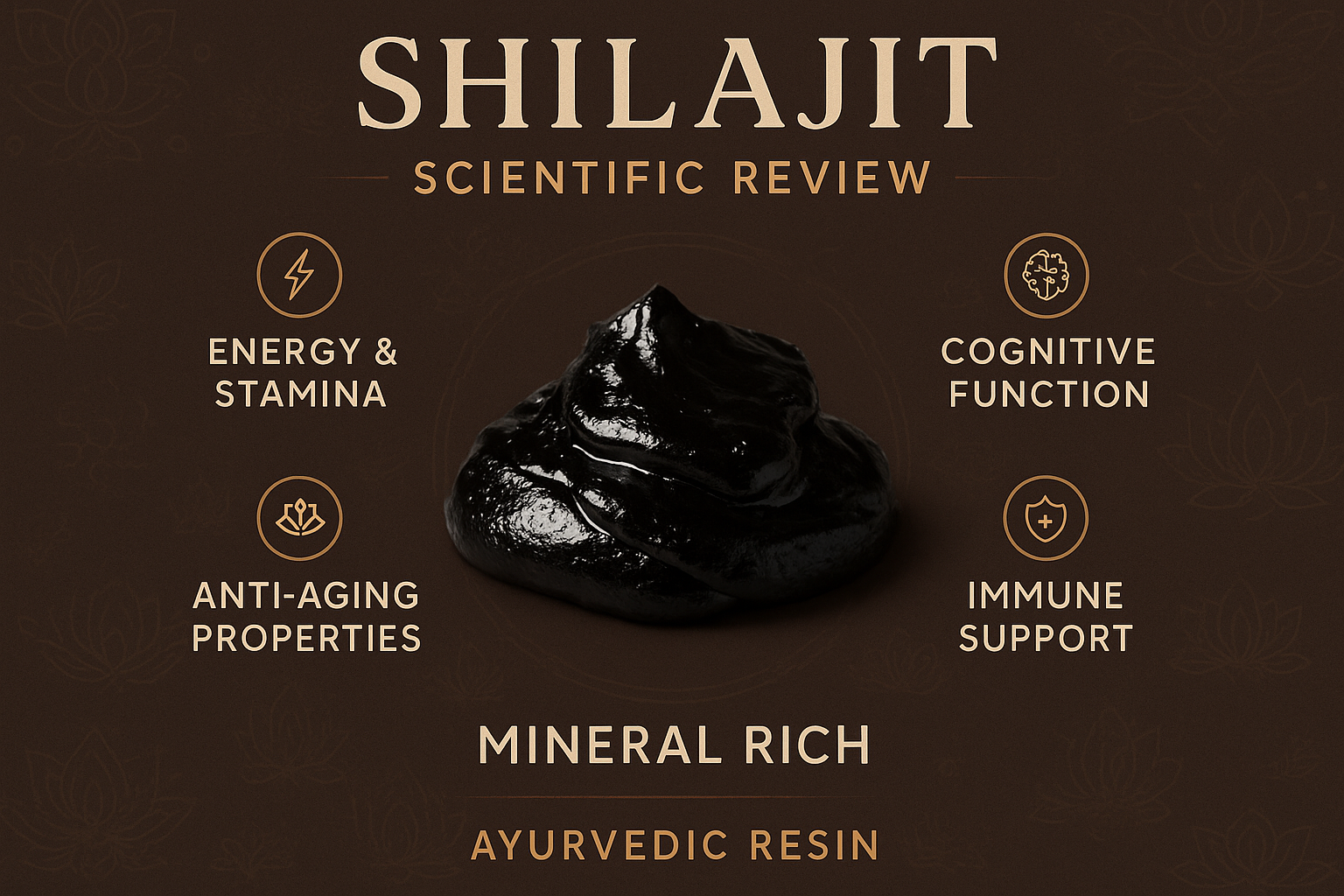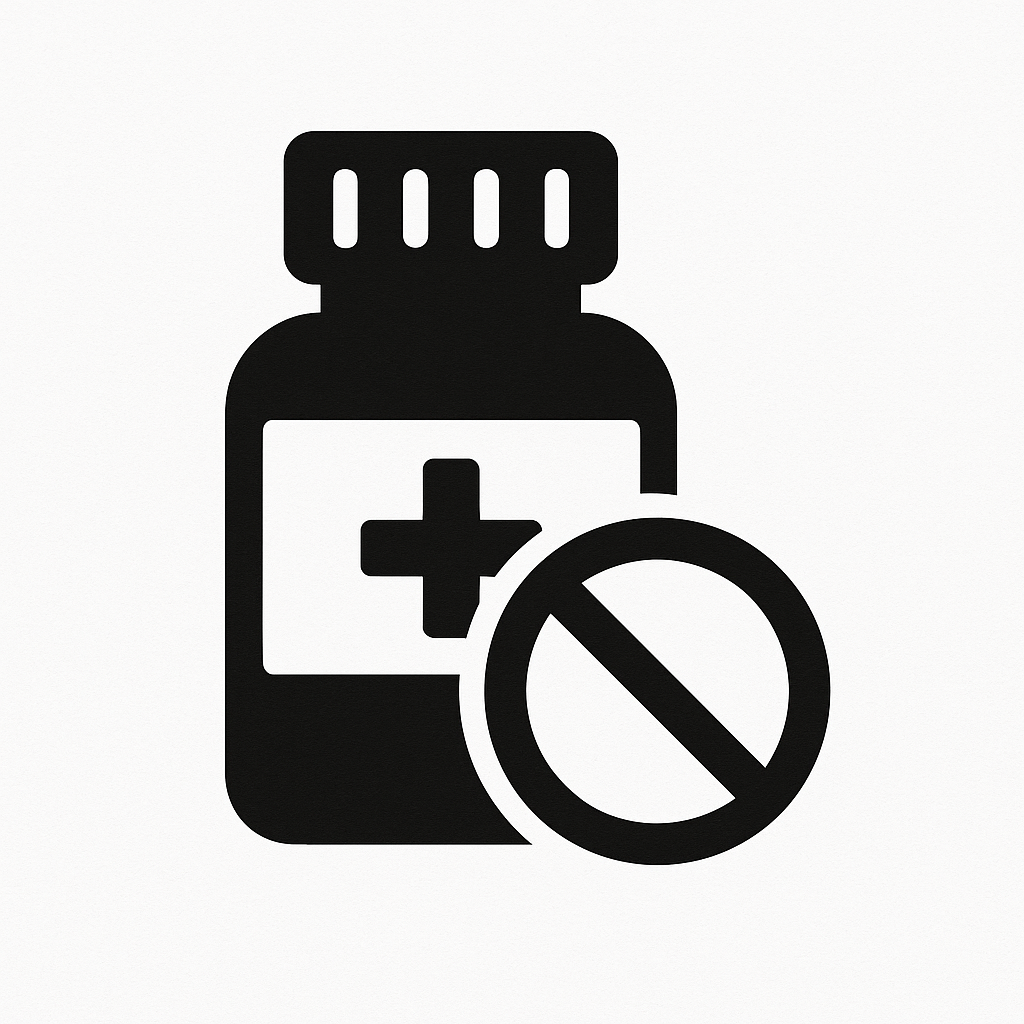
Shilajit Benefits: A Scientific Review of This Ayurvedic Resin
In the remote peaks of the Himalayas, Altai, Caucasus, and other high mountain ranges, a peculiar substance slowly emerges from rock crevices during warm summer months. This dark, tar-like resin—known as shilajit—has captivated healers and health seekers for over 3,000 years. Ancient Ayurvedic texts describe it as the "destroyer of weakness" and the "conqueror of mountains," attributing nearly miraculous healing properties to this mysterious substance.
For centuries, shilajit's reputation relied solely on traditional wisdom and anecdotal reports. However, in recent decades, modern science has turned its attention to this ancient remedy, uncovering fascinating insights about its complex composition and biological activities. What researchers have discovered helps explain why this resin has maintained its esteemed position in traditional medicine systems across multiple cultures.
This comprehensive review examines shilajit through the lens of contemporary science, exploring what we know about its composition, the evidence supporting various health claims, practical considerations for safe and effective use, and areas where research remains incomplete. By understanding both the promising findings and the limitations of current knowledge, you can make informed decisions about whether shilajit deserves a place in your wellness regimen.
What Is Shilajit? Origins and Formation
Understanding shilajit requires appreciating its unique geological and biological origins.
The Formation Process
Shilajit forms through centuries-long decomposition of plant material, primarily from species in the Euphorbia and Trifolium families, compressed between layers of rock. Microbial activity, extreme temperature fluctuations, and geological pressure transform this organic matter into a complex bioactive substance. The process takes hundreds to thousands of years, with the resin slowly exuding from rock fissures during warmer months.
Different geographic sources produce shilajit with varying compositions, though all authentic shilajit shares certain characteristic components. The primary sources include the Himalayan mountains (considered the gold standard), the Altai mountains of Siberia, the Caucasus mountains, and various ranges throughout Central Asia.
Physical Characteristics
Authentic shilajit appears as a blackish-brown to golden-brown sticky resin at warm temperatures, becoming rock-hard when cold. It possesses a distinctive earthy, somewhat bitter taste and characteristic aroma. When dissolved in warm water, genuine shilajit should completely dissolve, forming a golden or reddish-brown liquid without sediment.
The resin's appearance and consistency vary based on processing methods, with purified shilajit ranging from a soft paste to hardened resin to powder forms. Quality and purity significantly impact therapeutic potential, making source and processing crucial considerations.
Cultural and Traditional Context
In Ayurvedic medicine, shilajit is classified as a rasayana—a category of rejuvenating tonics believed to promote longevity, enhance vitality, and prevent disease. Traditional practitioners prescribed it for numerous conditions including weakness and fatigue, cognitive decline, sexual dysfunction, immune deficiency, digestive problems, and general rejuvenation.
Traditional Tibetan medicine similarly values shilajit (called brag-shun) as a strengthening and harmonizing substance. Russian folk medicine incorporates mumie (the Russian term for shilajit) for healing and performance enhancement. This cross-cultural reverence suggests genuine therapeutic value that transcends individual medical traditions.
Chemical Composition: What Makes Shilajit Special?
Modern analytical chemistry has revealed shilajit's remarkably complex composition, containing over 85 minerals and numerous organic compounds.
Fulvic Acid: The Key Active Component
Fulvic acid comprises 60-80% of shilajit's composition and appears responsible for many of its biological activities. This small organic acid molecule acts as a powerful electrolyte, enhancing nutrient absorption and cellular function. Fulvic acid chelates minerals, making them more bioavailable and facilitating their transport across cell membranes.
Research demonstrates that fulvic acid possesses antioxidant properties neutralizing harmful free radicals, anti-inflammatory effects reducing chronic inflammation, neuroprotective activities supporting brain health, and immune-modulating capabilities balancing immune responses. Its unique chemical structure allows it to interact with and influence numerous biological processes.
Humic Acid
Humic acid, a larger molecular cousin of fulvic acid, comprises 10-15% of shilajit. While less bioavailable than fulvic acid, humic acid contributes antioxidant activity and may support gut health by influencing the microbiome.
Dibenzo-Alpha-Pyrones (DBPs)
These unique organic compounds found in shilajit demonstrate significant biological activity. DBPs function as electron carriers in cellular energy production, acting as CoQ10 analogs to support mitochondrial function. They exhibit antioxidant properties and may enhance the effects of other shilajit components synergistically.
Mineral Content
Shilajit contains trace amounts of over 85 minerals in ionic form, including iron, calcium, copper, zinc, magnesium, manganese, selenium, and chromium. These minerals exist in bioavailable forms, chelated with fulvic acid for enhanced absorption. While individual mineral quantities are modest, the spectrum provides broad micronutrient support.
Other Bioactive Compounds
Shilajit also contains amino acids supporting protein synthesis and cellular function, vitamins including B-complex vitamins, plant sterols, and triterpenes with anti-inflammatory properties. This complex composition creates an entourage effect where components work synergistically, potentially explaining why isolated compounds don't fully replicate whole shilajit's effects.
Evidence-Based Health Benefits
Scientific research increasingly validates several traditional uses of shilajit while revealing new potential applications.
Energy and Mitochondrial Function
Perhaps shilajit's most substantiated benefit relates to cellular energy production. Multiple studies demonstrate that shilajit enhances mitochondrial function—the cellular powerhouses generating ATP, our primary energy currency.
Research published in the Journal of Ethnopharmacology found that shilajit supplementation significantly increased ATP production in muscle tissue. The mechanisms involve supporting the electron transport chain, enhancing CoQ10 function through synergistic DBPs, reducing oxidative damage to mitochondria, and improving oxygen utilization.
Users often report increased physical energy and reduced fatigue, with some research supporting improved exercise performance and endurance. A study in active adults showed that shilajit supplementation enhanced skeletal muscle adaptation to exercise, potentially improving strength and recovery.
Cognitive Function and Neuroprotection
Emerging research suggests shilajit may support brain health and cognitive function through multiple mechanisms. Fulvic acid crosses the blood-brain barrier, delivering its neuroprotective effects directly to neural tissue.
Studies indicate shilajit may help prevent accumulation of tau protein, which forms toxic aggregates in Alzheimer's disease. Research published in the International Journal of Alzheimer's Disease found that fulvic acid inhibited tau aggregation and disassembled preformed tau fibrils in laboratory models.
Additional cognitive benefits may include enhanced memory and learning through improved neural communication, neuroprotection against oxidative stress and inflammation, support for neurotransmitter production and function, and improved cerebral blood flow delivering oxygen and nutrients. While promising, most research remains in early stages, with human clinical trials still limited.
Testosterone and Male Reproductive Health
Shilajit has gained popularity for supporting male hormonal health, with scientific evidence supporting several traditional claims. A clinical study published in Andrologia examined the effects of purified shilajit on testosterone levels in healthy volunteers. After 90 days of supplementation, participants showed significant increases in total testosterone, free testosterone, and DHEA levels.
The mechanisms may involve providing minerals essential for testosterone synthesis (zinc, magnesium, boron), reducing oxidative stress that impairs testicular function, supporting mitochondrial function in Leydig cells producing testosterone, and potentially influencing the hypothalamic-pituitary-gonadal axis regulating hormone production.
Beyond testosterone, research suggests shilajit may improve sperm quality and count, enhance sexual function and libido, and support overall male reproductive health. These effects typically require consistent supplementation for 60-90 days before becoming apparent.
Anti-Aging and Longevity
Shilajit's traditional reputation as a rejuvenator aligns with modern longevity science. Its anti-aging potential stems from powerful antioxidant activity combating oxidative stress, mitochondrial support maintaining cellular energy, telomere protection potentially slowing cellular aging, and anti-inflammatory effects reducing chronic inflammation linked to aging.
Research demonstrates that shilajit's fulvic acid component exhibits remarkable antioxidant capacity, neutralizing various reactive oxygen species. This antioxidant activity extends throughout the body, protecting cellular components from damage accumulating with age.
Animal studies suggest shilajit may extend lifespan and improve age-related markers, though human longevity research is limited by the long timeframes required. Nonetheless, the biological mechanisms involved provide plausible pathways for anti-aging effects.
Inflammation and Immune Function
Chronic inflammation underlies numerous diseases, from cardiovascular conditions to autoimmune disorders. Shilajit demonstrates significant anti-inflammatory properties through multiple mechanisms including inhibiting inflammatory signaling pathways, reducing pro-inflammatory cytokine production, modulating immune cell activity, and protecting tissues from inflammatory damage.
Research in animal models shows that shilajit can reduce markers of inflammation and may help balance overactive immune responses. These immune-modulating effects potentially explain traditional uses for various inflammatory and immune-related conditions.
Heart Health and Metabolic Support
Preliminary research suggests cardiovascular and metabolic benefits from shilajit supplementation. Studies indicate potential improvements in lipid profiles with favorable effects on cholesterol and triglycerides, blood sugar regulation supporting healthy glucose metabolism, blood pressure management through vascular effects, and protection against oxidative damage to heart tissue.
A study in patients with heart failure showed that shilajit supplementation improved cardiac performance and reduced damage markers. While encouraging, more extensive human trials are needed to confirm cardiovascular benefits and establish optimal protocols.
Bone and Joint Health
Some research suggests shilajit may support skeletal health through enhancing calcium absorption and bone mineralization, reducing inflammation affecting joints, providing minerals essential for bone structure, and potentially influencing bone-building cellular activity. Traditional systems frequently used shilajit for bone and joint complaints, though rigorous modern research in this area remains limited.
Altitude Sickness and Oxygen Utilization
Interestingly, research indicates shilajit may help prevent altitude sickness, an effect potentially related to its traditional use in high-altitude regions. The mechanisms may involve improving oxygen utilization at the cellular level, enhancing red blood cell production, supporting energy production despite reduced oxygen, and reducing oxidative stress from hypoxia. This application has particular relevance for mountaineers and high-altitude travelers.
Quality, Sourcing, and Safety Considerations
Not all shilajit products are created equal. Quality varies dramatically, with implications for both efficacy and safety.
Purity and Authenticity Concerns
The shilajit market includes numerous adulterated or counterfeit products. Some contain minimal actual shilajit diluted with fillers, others include synthetic fulvic acid rather than natural resin, and concerning products may contain heavy metals or contaminants. Authentic, purified shilajit is relatively expensive due to limited supply and extensive processing required, making cheap products suspect.
Quality Indicators
When selecting shilajit, look for third-party testing for purity and heavy metals, reputable suppliers with transparent sourcing information, genuine Himalayan or Altai source identification, dark color and characteristic resin consistency, complete dissolution in warm water without sediment, and appropriate documentation of fulvic acid content.
Reputable suppliers should provide certificates of analysis showing testing results. Avoid products that seem suspiciously inexpensive or make exaggerated claims.
Forms and Processing
Shilajit comes in several forms including resin (most traditional and potent), powder (more convenient but may include additives), capsules (easy dosing but verify purity), and liquid extracts (variable quality and potency). Resin form generally offers the most authentic experience and highest quality, though it requires measuring and mixing.
Proper purification removes potential contaminants while preserving beneficial components. Traditional purification involves multiple filtration and heating cycles to remove impurities while concentrating active compounds.
Dosage Recommendations
Research studies typically use 250-500mg of purified shilajit daily, though traditional recommendations vary. Start with lower doses (around 250mg) and gradually increase while monitoring effects. Many practitioners recommend taking shilajit in the morning due to its energizing effects.
Shilajit is typically dissolved in warm water, milk, or tea, though capsules offer convenient alternatives. Consistency matters more than exact timing—regular daily use produces the most noticeable benefits, typically requiring 4-8 weeks of supplementation.
Safety Profile and Side Effects
When using pure, properly processed shilajit, side effects are rare and generally mild. Some users report slight digestive upset when first starting, which usually resolves. Taking shilajit with food may minimize any digestive discomfort.
Heavy metal contamination represents the primary safety concern with low-quality products. Unprocessed or poorly purified shilajit may contain concerning levels of lead, mercury, arsenic, or other toxins. This underscores the critical importance of sourcing from reputable suppliers providing testing documentation.
Contraindications and Precautions
Exercise caution or avoid shilajit if you have active gout or very high uric acid levels (shilajit may affect uric acid metabolism), sickle cell anemia, hemochromatosis or iron overload, or are pregnant or breastfeeding (insufficient safety data). Additionally, individuals taking medications should consult healthcare providers about potential interactions.
Shilajit may influence how the body processes certain medications and could affect blood sugar levels in diabetics. Medical supervision is advisable if you have significant health conditions or take multiple medications.
Practical Applications and Usage Tips
Maximizing shilajit's benefits requires understanding optimal usage strategies.
Best Practices for Consumption
For resin form, measure a rice-grain to pea-sized amount (approximately 250-500mg), dissolve in warm (not boiling) water, tea, or warm milk, stir until completely dissolved, and consume on an empty stomach or with a light meal. The taste is distinctive and earthy—some find it acquired, while others don't mind it.
For capsules, follow manufacturer recommendations, typically 1-2 capsules daily with water. Take consistently at the same time each day for best results.
Combining with Other Supplements
Shilajit combines well with certain supplements, potentially enhancing their absorption and effectiveness. Complementary combinations include CoQ10 (synergistic for mitochondrial support), ashwagandha (both are Ayurvedic adaptogens), omega-3 fatty acids (complementary anti-inflammatory effects), vitamin D (shilajit may enhance absorption), and B-complex vitamins (supporting energy pathways). However, start with shilajit alone before adding combinations to assess individual responses.
Cycling and Long-Term Use
Traditional Ayurvedic protocols often recommend continuous use for 3-6 months followed by breaks. Some practitioners suggest 8 weeks on, 2 weeks off cycles. However, safety data suggests long-term continuous use is acceptable with quality products.
Monitor your response over time—benefits should become apparent within 4-8 weeks. If no benefits manifest after 2-3 months of consistent use, shilajit may not be effective for you, or product quality may be insufficient.
Storage and Shelf Life
Store shilajit resin in a cool, dark place in its original container. Properly stored, quality shilajit remains stable for years. Avoid exposure to excessive heat, direct sunlight, or moisture. Capsules and powders should be kept in sealed containers away from humidity.
Limitations of Current Research
While promising, research on shilajit has limitations worth acknowledging. Many studies are conducted in animal models or cell cultures, with human clinical trials remaining relatively limited. Sample sizes in existing human studies are often small, and long-term safety and efficacy data spanning years or decades are scarce.
Standardization issues complicate research—shilajit composition varies by source and processing, making cross-study comparisons difficult. Many studies are funded by supplement manufacturers, potentially introducing bias. Additionally, optimal dosing, timing, and treatment protocols remain incompletely characterized.
These limitations don't negate positive findings but suggest the need for larger, longer, more rigorously controlled studies. Current evidence supports traditional uses while indicating areas requiring further investigation.
Realistic Expectations and Individual Variability
Not everyone responds identically to shilajit. Factors affecting individual responses include baseline health status and nutrient levels, quality and authenticity of the product used, consistency of supplementation, genetic factors affecting metabolism, and lifestyle factors like diet, exercise, sleep, and stress.
Set realistic expectations—shilajit isn't a miracle cure but rather a supportive supplement that may enhance overall vitality, energy, and wellness when combined with healthy lifestyle practices. Benefits tend to be subtle and accumulative rather than dramatic and immediate.
Some people notice significant improvements in energy, cognitive clarity, or other areas, while others experience minimal effects. Give shilajit an adequate trial (2-3 months of consistent use with quality product) before concluding whether it benefits you personally.
The Verdict: Does Science Support Traditional Claims?
Modern research increasingly validates many traditional uses of shilajit, particularly regarding energy production and mitochondrial function, cognitive support and neuroprotection, male hormonal health, antioxidant and anti-inflammatory effects, and potential anti-aging benefits.
However, research remains incomplete, with many effects demonstrated in laboratory or animal studies requiring confirmation in large-scale human trials. The evidence base is strongest for energy, testosterone, and cognitive benefits, while other traditional uses need more rigorous investigation.
Quality matters enormously—benefits require authentic, properly purified shilajit from reputable sources. The complex composition creating synergistic effects means isolated compounds don't replicate whole shilajit's benefits.
For those seeking natural approaches to enhance energy, support cognitive function, optimize hormonal health, or promote healthy aging, high-quality shilajit represents a scientifically plausible option with reasonable safety profiles. It's not a substitute for medical treatment of specific conditions but may serve as a valuable component of comprehensive wellness strategies.
Discover Quality Shilajit and Specialty Supplements
If you're interested in experiencing the potential benefits of this ancient Ayurvedic remedy, choosing authentic, properly purified shilajit from trustworthy sources is essential. Quality matters profoundly when it comes to this unique resin—only genuine, tested products can deliver the benefits described in traditional texts and modern research.
Explore carefully sourced specialty supplements, including authentic shilajit and other evidence-based wellness products, at Matevara's Specialty Supplements Collection.
Give your body the support of time-tested remedies validated by modern science. Your journey to enhanced vitality starts with quality.
Disclaimer: This article is intended for informational and educational purposes only and should not be construed as medical advice, diagnosis, or treatment recommendations. The information provided about shilajit, its composition, potential benefits, and usage guidelines is based on traditional knowledge, available scientific research, and general health principles, but individual responses vary significantly based on health status, genetics, medications, and other factors. Shilajit is a dietary supplement, not a medication, and is not intended to diagnose, treat, cure, or prevent any disease. The statements about shilajit's effects and benefits have not been evaluated by the Food and Drug Administration. Always consult with qualified healthcare professionals, including your physician or registered healthcare practitioner, before starting any new supplement regimen, particularly if you have preexisting medical conditions such as gout, hemochromatosis, sickle cell anemia, or other health concerns; take prescription medications that might interact with supplements; have hormone-sensitive conditions; are pregnant, trying to conceive, or breastfeeding; or have a history of kidney stones or kidney disease. Quality and purity of shilajit products vary enormously in the marketplace, with some products potentially containing heavy metals or contaminants that pose serious health risks. Only use shilajit from reputable suppliers who provide third-party testing documentation verifying purity and absence of contaminants. The dosage recommendations provided are general guidelines—optimal dosing varies based on individual factors and product concentration. Never exceed recommended dosages, and discontinue use if you experience adverse effects. This article reflects current understanding based on available research, which remains incomplete in many areas. Long-term safety and efficacy data spanning decades are not available for shilajit supplementation. This information cannot replace personalized medical advice from healthcare professionals who can evaluate your specific situation, review your medical history, assess potential interactions with your medications, and provide recommendations tailored to your individual health needs and circumstances.
Share








